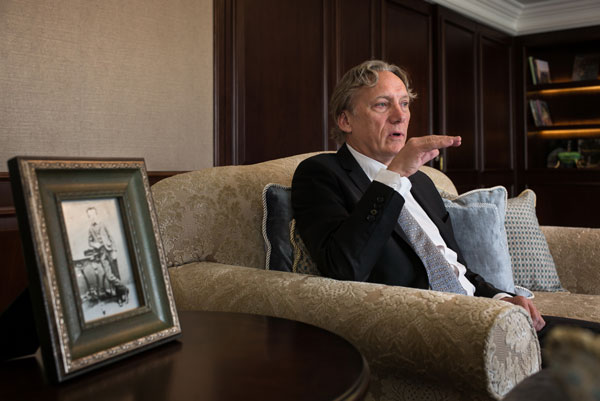Van Gogh's art makes a high-tech reach to China
|
 Vincent Willem van Gogh is ambassador of the Van Gogh Museum and adviser to its board of directors. Dai Ruoying / For China Daily |
The Van Gogh Museum works hard to keep the legacy of one of the world's most important artists alive.
A recent invention to support its efforts are Relievos, high-end and state-of-the-art 3-D replicas of Van Gogh's paintings, which were made possible by a seven-year cooperation between the museum and Fujifilm Europe.
Last year, the museum released worldwide the Relievo collection, consisting of five iconic works by Van Gogh (1853-90): Almond Blossom, Sunflowers, The Harvest, Wheatfield under Thunderclouds and Boulevard de Clichy.
They are on sale in limited editions of 260.
Now the collection has come to Beijing. The five paintings are on show at the Manet Art Collection, an art space in an upscale club in the capital's western suburb, with a price tag of 250,000 yuan ($40,087) each.
"We released reproductions on canvas 15 years ago and finally, we have developed reproductions that are so close to the originals," says Vincent Willem van Gogh, who is visiting Beijing to promote the Relievos. The great grandson of Theo van Gogh, the artist's younger brother, serves as an ambassador of the museum and adviser to its board of directors.
Technicians at Fujifilm's lab in Belgium created the works with a sophisticated technology called Reliefography. The process closely monitored by the museum's curators combined 3-D scanning and high-resolution printing.
The paintings were fit into handmade reproductions of original frames, and attached on the back with seals from exhibitions where the original works had been shown.
"They (the reproductions) feature the same size, colors, brightness and texture as the original ones. People on both sides are very motivated to make it match the standards for our museum, and for the art of Van Gogh. It's quite an investment," Willem says.
The five paintings were selected not only because they are among Van Gogh's most celebrated works, but also because they represent several different stages in his development as an artist.
Boulevard de Clichy, for example, was created in 1887 when Van Gogh worked in Paris where he started to become a Modernist artist. In a letter to British painter Horace Mann Livens (1862-1936), Van Gogh wrote, "There is but one Paris and however hard living may be here and if it became worse and harder even - the French air clears up the brain and does one good - a world of good".
The Relievos are the first step for the museum to have a presence in China. A Chinese edition of complete letters from Vincent to his brother Theo will be published by the Shanghai Culture and Art Publishing Group in September.
"There are many different dimensions to him (Vincent van Gogh). On one hand, we want to show people what he made. Also we want to make accessible more information about him as a person - for example, he was a very avid letter writer," says Axel Ruger, the museum's director, who is also visiting Beijing.
He says the upcoming book of letters provides an incredible insight into the artist; and a fair number of letters also contain sketches and drawings that refer to his paintings.
The Amsterdam-based museum claims to have the world's largest collection of Van Gogh's work, including 200-odd oil paintings, 500 sketches and 800 letters. It annually receives nearly 1.5 million visitors, whose average age is 32.
Willem van Gogh says it proves young people's enduring fascination with the artist.
"The number of visitors is still increasing. Thanks to the latest technology, people can enjoy Van Gogh's art via social media and ultimately, they do want to see the real ones, and get the feeling of who Van Gogh was and of visiting where he grew up," Willem says.
The museum will launch a new website in more languages.
"Chinese will be one of them. Once we raise enough money to finance it, we will certainly intensify our relationship with the Chinese audience," he says.
"Chinese tourists who come to the Netherlands don't visit our museum that much. That's really what we should work on - to get the visitors to not only see the windmills, but also visit museums.
"In the mid- to long term, we certainly are interested to see whether we can organize an exhibition in China as we've done in other countries already. This is a big market, obviously."
linqi@chinadaily.com.cn


















